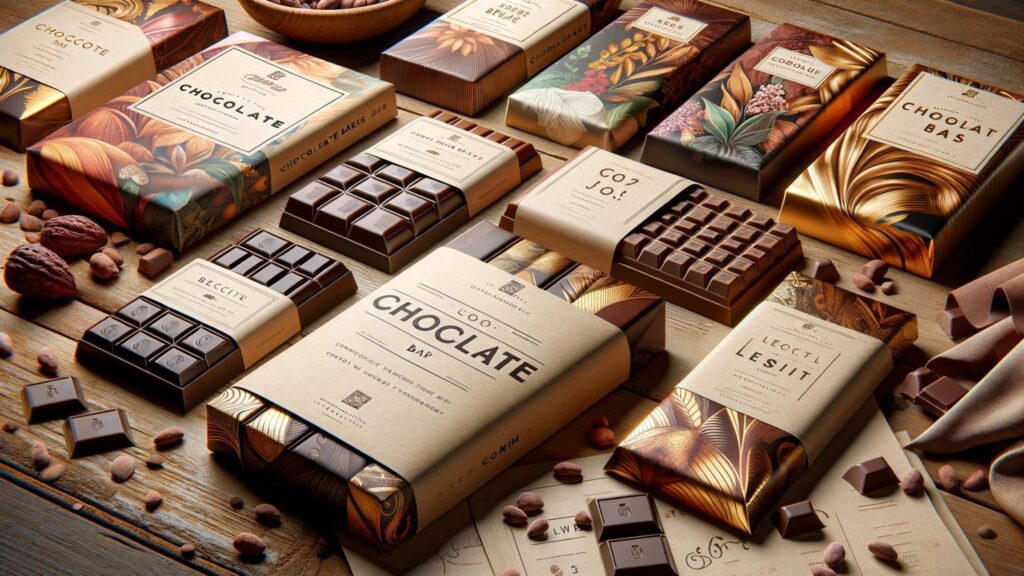Chocolate bar packaging plays a crucial role in attracting customers, protecting the product, and communicating brand identity. Whether it’s a luxurious artisanal chocolate bar or a fun, mass-market treat, packaging design significantly influences purchasing decisions. In this post, we’ll explore the key elements of effective chocolate bar packaging and how brands can make a lasting impression through their designs.
Importance of Chocolate Bar Packaging
- First Impressions Matter
The packaging is often the first thing a customer notices. A well-designed wrapper or box can entice buyers and create a strong emotional connection. Colors, typography, and imagery all contribute to the overall appeal, helping a chocolate bar stand out on crowded shelves. - Brand Identity and Storytelling
Packaging is a powerful branding tool. It communicates the values, story, and uniqueness of a chocolate brand. Whether emphasizing sustainability, luxury, or playfulness, a well-crafted design reinforces brand identity and fosters customer loyalty. - Product Protection and Freshness
Beyond aesthetics, chocolate bar packaging must ensure the product remains fresh and intact. High-quality materials, such as foil linings, resealable wrappers, and eco-friendly alternatives, help maintain taste and texture while minimizing waste.
Key Elements of Effective Chocolate Bar Packaging
1. Eye-Catching Design
- Color Psychology: Dark hues convey richness and luxury, while bright, playful colors appeal to younger audiences.
- Typography: Elegant fonts exude sophistication, while bold, quirky fonts add a fun, modern touch.
- Imagery: High-quality visuals, such as cocoa beans, melting chocolate, or artistic illustrations, enhance appeal.
2. Sustainable Packaging Options
- Biodegradable Wrappers: Many brands are shifting to compostable or recyclable packaging to reduce environmental impact.
- Minimalist Designs: Simple, eco-conscious packaging with less plastic resonates with environmentally conscious consumers.
- Reusable Containers: Some high-end chocolate brands use reusable tins or paper-based wraps as a premium, sustainable alternative.
3. Informative and Transparent Labeling
- Ingredient List: Clear, honest labeling builds trust with health-conscious consumers.
- Certifications: Labels like “Fair Trade,” “Organic,” or “Vegan” provide credibility and attract niche markets.
- Allergy Warnings: Proper allergen labeling ensures consumer safety and compliance with regulations.
Trends in Chocolate Bar Packaging
- Personalization: Custom wrappers for special occasions or limited-edition releases create exclusivity.
- Interactive Packaging: QR codes linking to brand stories, recipes, or digital experiences engage customers.
- Artisanal Appeal: Hand-drawn illustrations and textured materials elevate the perceived value of gourmet chocolates.
- Retro Revival: Vintage-inspired designs with nostalgic fonts and patterns are making a comeback.
Conclusion
Chocolate bar packaging is more than just a wrapper—it’s a blend of creativity, functionality, and branding. A well-designed package not only preserves the chocolate but also entices consumers, tells a story, and reinforces brand loyalty. By embracing sustainability, aesthetics, and innovation, chocolate brands can create packaging that leaves a lasting impression.
Are you a chocolate brand looking to enhance your packaging? Share your thoughts and favorite designs in the comments below!
Related Articles
- The Art and Science of Packaging | Trends, History & Future
- T Shirt Packaging: The Ultimate Guide to Making a Lasting Impression
- Types of Tertiary Packaging: Essential Solutions for Logistics & Shipping
- Tertiary Food Packaging: An Essential Component of the Supply Chain
- Tertiary Packaging in Pharmaceutical Industry: An Essential Component of Supply Chain Efficiency
- Understanding Primary Secondary and Tertiary Packaging
- Tertiary Packaging Examples: Understanding Its Role in Logistics
- What is Tertiary Packaging? Definition, Purpose, and Benefits
- The Importance of Secondary Packaging Material in Modern Supply Chains
- Secondary Packaging Examples: Enhancing Protection and Presentation

